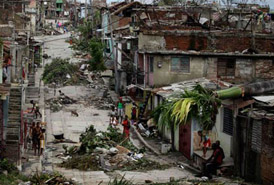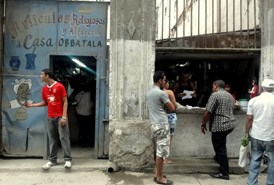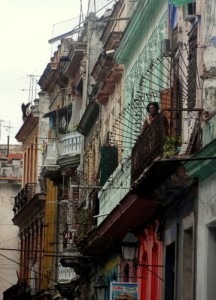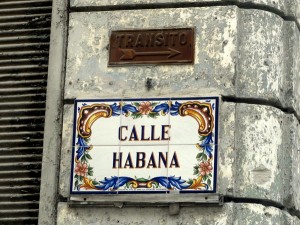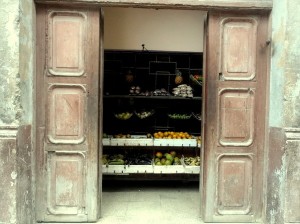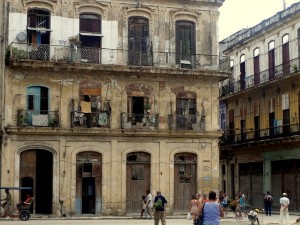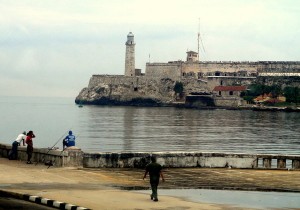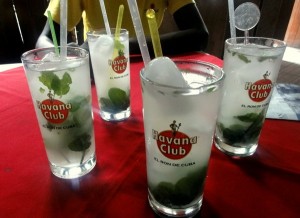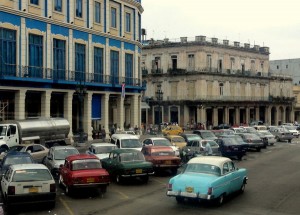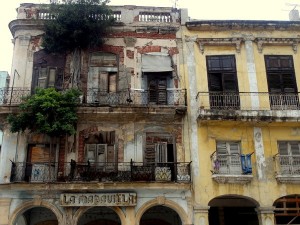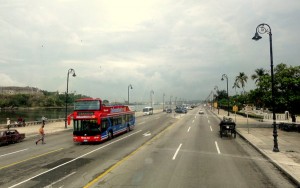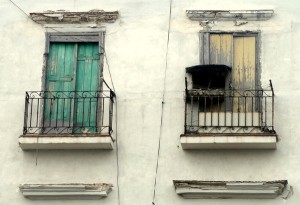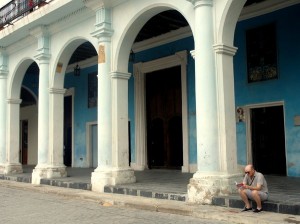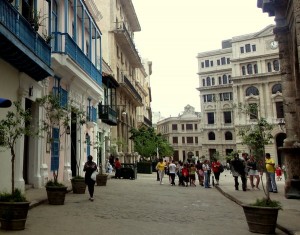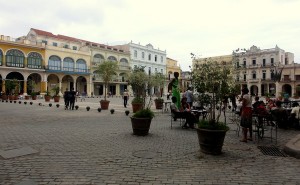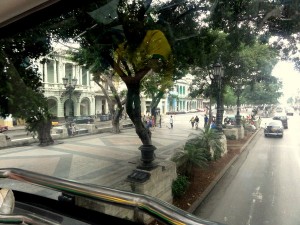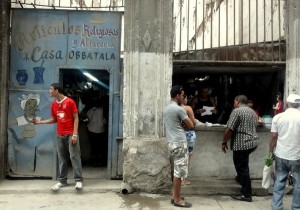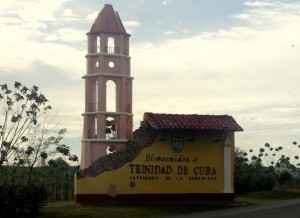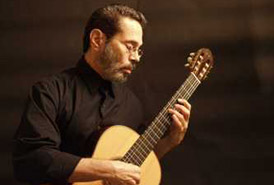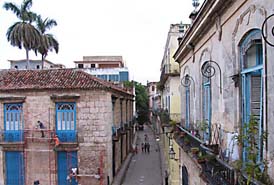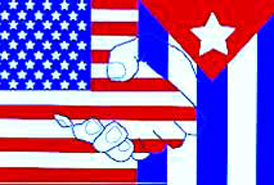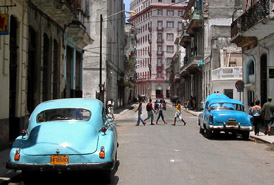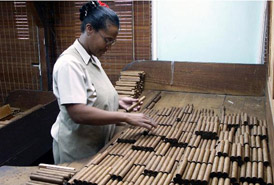Americans account of Hurricane Sandy in Cuba
Hurricane Sandy in Cuba
As I write this column, after arriving home this weekend and, after yet another overwhelming storm on our east coast, despite planning for the worst, my family and I have emerged unscathed while thousands of homes in Cuba are still without power and water following the wrath of Hurricane Sandy in Cuba.
Although I was lucky and missed the eye of the storm, I got a good taste of Hurricane Sandy in Cuba as I was in Varadero last week.
On our drive back from Havana in our tiny Cuban Rent A Car Thursday, the storm was brewing. The ocean was irritated, transferring tides of seawater across the roads and flooding the streets. Locals marooned in the rain fruitlessly huddled under umbrellas as family pets ran toward the comfort of home.
Returning to the Tryp Peninsula resort, the maids worked untiringly to sweep out water that had snuck its way into the lobby as they loathed in Spanish over Hurricane Sandy in Cuba
The hallways were soaked and the power went off and on throughout the night. It was probably the only evening vacationers weren’t sampling the country’s rum and cigars in the disco.
Instead, we were stuck up in our hotel rooms, hoping and praying that nothing would break and fly through the windows. I had premeditated to lock myself in the bathroom until the vicious storm was over.
Fortunately I didn’t resort to that, but my Cuban girlfriend and her parents had to put her survivor skills to the test. She had hopped off her bed and slipped, with a rude realization that her floor was soaked. Water had seeped into her third-floor room from the outside and her windows were shaking uncontrollably. After pushing her belongings into the bathroom and closet, and a few slips and falls in the pitch-dark hallways, she made her way to the safety of my room.
“Hurricane Sandy in Cuba devastation”
Sadly, not everyone made it home in Cuba; 16 people died across the island. Roofs caved in, roads were destroyed and livestock was lost. In Santiago, mass was held in the street after churches were wiped out. Our tour guide on the return trip to Havana´s Jose Marti Airport said one of the company’s employees had gone fishing for red snapper after the hurricane since they’re abundant after such storms. He’s been missing since. He also updated passengers on our bus about other Hotels Hurricane Sandy in Cuba such as the Meliá Santiago de Cuba, Versailles, Casa Granda, Villa Colibri, Sierra Mar and Rancho Club with fallen ceiling structures, damaged false ceilings, sheds, awnings, landscaping, electrical and fresh water networks, glassware, solar heaters and beaches severely eroded. He also said that Hotel Bucanero was completely destroyed…
It got me thinking how lucky I am to live in Maryland, where such storms usually dissipate before reaching us.
In New York, the colleges and universities were closed and Wall Street remained closed for the second consecutive day. Our east coast is water logged and badly beaten but, as usual, FOX news is back to the elections as if nothing happened.
I bet the people of Cuba are still reeling in the wake of the disaster though
Hurricane Sandy in Cuba 2012
Whats on in Havana this October
Interested in finding out what’s going on in Cuba during your stay there? Find seasonal info here on festivals, exhibits, conventions, concerts, and more. The guide cover Havana and other major cities and Cuba Events in general
Download the latest Havana events schedule
What’s On Havana – October 2012
Sponsored by: Cuba Travel USA
Cuba People to People Travel setbacks?
Cuba People to People Travel
Why it is happening, nobody is sure. But the Cuba People to People travel program touted so highly by President Obama in 2011 is coming to a screeching halt, drowning in paperwork and non-renewed licenses for travel organizations.
Almost no organizations that got licenses from the U.S. Treasury Office of Foreign Assets Control (OFAC) last year to for Cuba People to People Travel to sponsor trips to Cuba have received renewals. Cuba People to People Travel Trips that were advertised have been scrapped. Organizations are left to wait without any updates or information.
“We work with about 30 different non-profit organizations that have programs to Cuba in next 12 months, and 100% of them have not received renewals of licenses,” said Jim Friedlander, president of Academic Arrangements Abroad in New York, a travel service provider, late Tuesday.
He said that the practical effect of OFAC’s lack of activity is that it disrupts the entire People to People program.
To me, this is contrary to the whole purpose of the president’s 2011 loosening of travel for Americans to Cuba and more specifically his efforts concerning Cuba People to People Travel.
Because of the outdated U.S. embargo against Cuba that makes it illegal for Americans to travel there, most Americans have never been to Cuba unless on a family or religious visa. The People to People cultural travel program finally allowed thousands of regular travelers to visit last year and early this year, interacting with Cubans in a meaningful way.
But in May, the OFAC application for a license to operate trips under Cuba People to People Travel grew from 6 pages to essentially hundreds of pages. Organizations seeking renewal had to document every minute of every day for every single trip they had done in the past year to prove that they were doing “People to People” activities and not tourism.
Then, most of them heard nothing. Weeks and months passed. Licenses lapsed. Since OFAC is notoriously closed-mouth about its work and does not make public its list of licences, applicants have been able to get little information. But gradually they realized they were all in the same predicament.
The U.S. Treasury press office on Tuesday did email me a comment from Jeff Braunger, program manager for Cuba Travel Licensing: “We have issued approximately 140 people-to-people licenses. We are doing our best to process both first-time applications and requests to renew existing licenses. We receive numerous such requests which are being handled in turn. It is our goal to respond in a timely matter.’’
I think this is approximately one paragraph more information than all the organizations waiting for their renewals have gotten from his office.
The thing that alarms me most is that the groups I’ve talked to seem intimidated and scared. Those awaiting licenses for are afraid of going public with their concern, worried that if they seem to be complaining about months of delays that have caused them to cancel trips, lose money and lay off staff, that OFAC will punish them by stowing their application on the bottom of a giant pile.
“U.S. Treasury impides Cuba People to People Travel”
I don’t think that’s true, but the very fact that companies are so skittish concerns me greatly. These are not fly-by-night groups. Typical groups that have or had Cuba “People to People” licenses include Harvard Alumni, The Metropolitan Museum of Art, National Geographic, Insight Cuba and the National Trust for Historic Preservation, all reputable groups that ran ethical and very good culturally-rich trips.
Now, a look at their websites tells the story. Harvard has one trip planned for Dec. 27 but with this caveat: “Pending ‘Cuba People to People travel” license renewal.” The Met wiped Cuba off its itinerary for now. National Geographic, which has run 29 trips taking 703 people total in the past year, is taking only preliminary waiting-list reservations for fall trips with no deposit. (A deposit, according to OFAC rules, is engaging in financial transaction with Cuba and illegal if you have no license) Insight Cuba has suspended all trips for the past two months and is on hold, waiting for its renewal that expired in June. National Trust has 4 Cuba trips still on its 2012 itinerary, but with an asterisk: “Pending People to People License Renewal.”
Whether you are pro-Cuba travel or anti-Cuba travel, this whole thing should concern you a lot. There is something sinister to me about preventing citizens from traveling under Cuba People to People travel, then allowing them to do so, then throwing giant roadblocks to prevent them from going after all.
So why is it happening?
It could be election year politics, with OFAC personnel covering their bases in case Democrats are out in November and Republicans take over.
It could be undue influence from the small but mighty faction of anti-Cuba types in Congress.
It could be the White House consciously deciding to slow down the program for political reasons in exchange for something it wants from Cuba.
Or it could just be bureaucratic overload, with hapless workers struggling under an avalanche of paperwork it thought it needed and no deadline, and meanwhile these worthy groups that have done so much work to run People to People trips to Cuba lose money, customers and confidence in their government.
Sponsored by Cuba Travel US – Offering trips to Cuba since 2001
Cuba People to People travel update
Cuba Coffee and tobacco plantation tour
Cuba Classic Car Tours
Cuba Adventure Cultural Tour
An Americans Trip to Cuba | Report & Review
In 2012, Cuba has the attraction of forbidden fruit for the US traveler because it is just 90 miles from the US alas, as yet illegal for most Americans to visit. Cuban as well as US histories are entwined with many forced attempts by the US government to conquer Cuba in the nineteenth century. I was able to travel to Cuba legally because of my academic needs although, I met many who were flaunting the rules (more on that later). I booked a charter flight from Miami to Havana, the short 42 minute flight left no doubts as to how close the island is for those who may have not seen a map lately…forced to be there 4 hours prior to the flight due to government autocracy and paperwork. Luggage was weighed several times. It cost me $18 to be 9 pounds over the 44 pounds max suitcase weight.
During our stay in Cuba we had a local Cuban guide, as well as 2 drivers for our large comfortable Hyundai VAN booked through CubaCAR. Our driver was adept at outlining the Cuban way of seeing things which at times was humorous. Our guides stayed with us throughout the whole 14 day trip to Cuba. We stayed in some excellent Cuban hotels enjoying live music at every lunch, dinner and afterwards…
Havana
Our time in Havana was spent seeing Old Havana, the infamous Malecon and a short drive around the more modern (in Cuban terms…) Miramar District. Gorgeous facades and architecture was to be found everywhere throughout Havana but probably more concentrated in the Old Town section. Founded in 1515, Havana was the for the most part the most fortified city of the New World as well as being successfully invaded only once. The British conquered Havana In 1762, as well as holding Cuba for 11 months before then trading it back to Spain for Florida…(must have been fun back in those days…) Modern day Havana is now a city of 2.4 million and is in poor condition as well as crumbling buildings, the streets and main arteries of the City are in terrible shape. Luckily major restoration work is now in progress on junks of the city. Be sure to catch Anthony Bourdains latest “No reservations” which seem to catch lots of what I myself saw.
Incredibly, when Castro senior (before his brother…) came to power on January 1, 1959, the standard of living in Cuba was the highest of any Latin American country. Now the minimum wage is $5 per month and, by the looks of the beggars and constant hassles people are in need.. As we all know, Cuba is a socialist country, there is a highest wage as well of $32 a month. Rationing of food supplies via the bodegas has been a way of live in Cuba since 1962, for food, soap, clothing, gasoline, etc. Each family gets a monthly ration book but, many Cubans companied to us that they rarely get their rations and that these are being cut more and more due to the dire economics circumstances the government is in. After the collapse of the socialist countries in 1989, Castro allowed farmers markets to exist and his brother Raul is now pushing more self employment in a make shift type of free economy where the state still controls all raw materials and supplies. The elder Castro made the US dollar legal tender in 1993 along with the Cuban peso. During our 14 days we were in Cuba, we exchanged dollars for both Cuban Pesos CUC´s and also Cuban Pesos the national money. Rather confusing but we quickly learnt that CUC´s were the sole currency in tourism locations and CUP were more for small street vendors etc. All Cubans are very eager to get US dollars. The averages Cubans saw me as if I was a millionaire because I was paying a hotel as well as food the equivalent of their average annual wage. Cubans have only recently been allowed to visit and stay at Hotels and, for the greater part of the population they are still (financially) out of bounds. Many Cubans told us that the only reason Raul Castro allowed them to stay at Hotels was so that family abroad would send more money…quite probable judging by Cuba´s economy..
The 1950s cars running around Havana are not all they were cracked up to be and, despite being a culture shock, any Americans who think that there´s a goldmine of 50´s cars in Cuba should think again. These cars have rarely any parts remaining on their disheveled bodywork. There are many Russian cars from the 70s as well as the 80s as plus quite a number of newer more modern cars. One-horse buggies as well as the Coco Taxi (fiber glass egg transplanted on a Vespa) motorcycles with an open air plastic bubble for 2 passengers. Rickshaws are common in other cities around Cuba and we saw quite a few in Havana. Horses are also used to haul cargo around. Car traffic is minimal as well as there being no parking meters (great!!) or parking regulations to speak of. However, there is no mistaking Cuba is a poor country. This is surprising because of its mild climate, extraordinary tourist attractions, arable lands plus the major development before the Castro’s took control.
One highlight in Havana was a visit to the Partagas Cigar factory where they make Habanos and Monte Cristo Cigars. At the time of the Spanish conquest, Cuba was inhabited by the Taino Indians, their word for tobacco was tobacco! The factory is located to the rear of the Capitol building and was founded in 1845. Workers were casually dressed in the factory, as well as typical; striking Cuban melodies playing loudly over loud speakers. Men and women of various ages are the artisans who make the cigars. One old aged woman was constantly puffing on a huge specially made cigar. All cigars are still made by hand of course. All of the world-famous brands are created at this factory. All cigars are packed into a box and sorted to obtain a perfect color shade. A little trick I was shown…each cigar is individually turned to its best side. This factory is where they make the world’s best cigars and always have. This factory is older than the Cuban flag (1850) and has survived 3 revolutions, so far.
I shall write further comments about my trip in the coming weeks
Thank you
Geoffrey G. Miller
Thanks to Cuba Travel US for the hotel, car, guides and general help and, also Marazul for the flight arrangements
Paladares Havana | Castas y Tal
Just around the corner from Hotel Presidente you´ll find Castas y Tal situated on the 11th floor of a large apartment building in Vedado, just around the corner from Hotel Presidente. The restaurant has three areas, a main dining room that can seat eight, an indoor terrace with glass windows and a side area where you can have an excellent caipirinha prepared with eau de vie (fruit brandy), and caipiroska (with vodka). This is not a slick mega-paladar but a homely lounge.
A young Cuban entrepreneur Jonathan Reyes and chef Ransys Valdés knows and loves her food. With a German grandmother, Chinese uncle and various Spanish relatives, she has plenty of influences.
The food is light, fresh and healthy. Croquettes, tapas and Spanish omelettes are delicious but do not sit like a lead balloon in your stomach. Everything possible is made in house. Several dishes are special recipes of Ransys: cordero casto is boned lamb cooked with masala spices; pollo y tal (boned chicken with vegetables in pineapple juice and ginger); shrimps in rosemary sauce; and roast beef in mushroom sauce. You have to try the Piso 11 dessert – French bread with eggs, red wine, vanilla ice-cream, hot chocolate and ginger. Standard Spanish and Chilean wines should be available.
Try our sponsor for car rental in Cuba or a hotel in Havana
Address • Calle E No 158 B, between Calles 9a and Calzada, Vedado +537 833 1425




